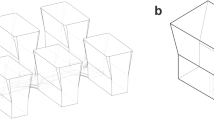Abstract
This study investigated the reasons for the irregular structure of primary graphite nodules that were formed in a hypereutectic cast iron powder during water atomization. The graphite nodules contain a significant amount of micron-sized pores and multiple nanometric voids that formed from silicon oxide bifilms. The bifilms theory is often used to explain the mechanisms responsible for the presence of pores in castings. However, even if many results presented in the literature tend to corroborate the existence of bifilms, to this date, only indirect evidences of their existence were presented. The observations presented in this paper are the first to show the double-sided nature of these defects. These observations support the bifilms theory and give an explanation for the presence of porosities in castings. The bifilms were used as substrate for graphite growth during solidification. The irregular structure of the graphite nodules is a consequence of the rather random structure of the bifilms that were introduced in the melt as a result of turbulences on the surface of the melt during pouring. The confirmation of the existence of bifilms can contribute to the understanding of the mechanical properties of various metallic parts.






Similar content being viewed by others
References
J. Campbell, Complete Casting Handbook: Metal Casting Processes, Metallurgy, Techniques and Design ; John Campbell (Elsevier, Oxford, 2011).
J. F. Major, AFS Trans. 105, 901 (1998).
G. Lasko, M. Apel, A. Carre, U. Weber, and S. Schmauder, Adv. Eng. Mater. 14, 236 (2012).
T. J. Marrow, J.-Y. Buffiere, P. J. Withers, G. Johnson, and D. Engelberg, Int. J. Fatigue 26, 717 (2004).
Z. Yang, J. Kang, and D. S. Wilkinson, Metall. Mater. Trans. B Process Metall. Mater. Process. Sci. 46, 1576 (2015).
P. D. Lee, A. Chirazi, and D. See, J. Light Met. 1, 15 (2001).
P. N. Anyalebechi, J. Mater. Sci. 48, 5342 (2013).
L. Yao, S. Cockcroft, C. Reilly, and J. Zhu, Metall. Mater. Trans. A Phys. Metall. Mater. Sci. 43, 1004 (2012).
L. Liu, A. M. Samuel, and F. H. Samuel, J. Mater. Sci. 38, 1255 (2003).
J. Zeng, D. Li, M. Kang, H. He, and Z. Hu, J. Nanosci. Nanotechnol. 13, 6948 (2013).
R. C. Atwood, S. Sridhar, and P. D. Lee, Scr. Mater. 41, 1255 (1999).
J. Campbell, Metall. Mater. Trans. B Process Metall. Mater. Process. Sci. 42, 1091 (2011).
J. Campbell, Mater. Sci. Technol. 22, 127 (2006).
J. Campbell, J. Mater. Sci. 51, 96 (2016).
D. Dispinar and J. Campbell, Int. J. Cast Met. Res. 17, 280 (2004).
D. Dispinar and J. Campbell, Int. J. Cast Met. Res. 17, 287 (2004).
D. Dispinar and J. Campbell, Int. J. Cast Met. Res. 19, 5 (2006).
W. D. Griffiths and R. Raiszadeh, J. Mater. Sci. 44, 3402 (2009).
D. Dispinar, S. Akhtar, A. Nordmark, M. Di Sabatino, and L. Arnberg, Mater. Sci. Eng. A (Structural Mater. Prop. Microstruct. Process., 2010, vol. 527, pp. 3719–25.
D. Dispinar and J. Campbell, Mater. Sci. Eng. A 528, 3860 (2011).
G. Eisaabadi Bozchaloei, N. Varahram, P. Davami, and S. K. Kim, Mater. Sci. Eng. A 548, 99 (2012).
A. M. Samuel, F. H. Samuel, and H. W. Doty, J. Mater. Sci. 31, 5529 (1996).
D. N. Miller, L. Lu, and A. K. Dahle, Metall. Mater. Trans. B Process Metall. Mater. Process. Sci. 37, 873 (2006).
X. Cao and J. Campbell, Mater. Trans. 47, 1303 (2006).
K. Liu, X. Cao, and X.-G. Chen, Metall. Mater. Trans. B Process Metall. Mater. Process. Sci. 46, 1566 (2015).
J. Campbell and M. Tiryakioglu, Metall. Mater. Trans. B Process Metall. Mater. Process. Sci. 43, 902 (2012).
J. Campbell, Metall. Mater. Trans. B Process Metall. Mater. Process. Sci. 40, 786 (2009).
B. Puhakka, in (Shape Cast., John Wiley & Sons, Inc., 2011), pp. 79–85.
B. Puhakka, in (Shape Cast., John Wiley & Sons, Inc., 2011), pp. 241–248.
R. M. German, Powder Metallurgy and Particulate Materials Processing (Metal Powder Industries Federation, Princeton, 2005).
D. B. Williams and C. B. Carter, Transmission Electron Microscopy. Imaging. III (Springer, New York, 1996).
C. W. Bale, E. Belisle, P. Chartrand, S. A. Decterov, G. Eriksson, K. Hack, I. H. Jung, Y. B. Kang, J. Melancon, A. D. Pelton, C. Robelin, and S. Petersen, CALPHAD Comput. Coupling Phase Diagrams Thermochem. 33, 295 (2009).
A. Sommerfeld and B. Tonn, in (American Foundry Society 1695 North Penny Lane Schaumburg IL 60173-4555 United States, 2009), pp. 39–47.
I. Riposan, M. Chisamera, S. Stan, C. Ecob, and D. Wilkinson, J. Mater. Eng. Perform. 18, 83 (2009).
A. De Sy, Mod. Cast. 52, 67 (1967).
Acknowledgments
The authors thank their collaborators for their technical assistance for the work presented in this paper: the members of the laboratory LAMPOUL directed by Carl Blais, professor at Université Laval, for the powder atomizations, and Jean-Phillipe Masse from the Center for Characterization and Microscopy of Materials, the (CM)2, for his help with TEM observations.
Funding
The authors would like to acknowledge the financial support of Federal-Mogul Powertrain and AUTO21, a multi-disciplinary, auto-related research and development (R&D) initiative established by the Canadian Networks of Centres of Excellence (NCE) program. AUTO21 is funded by a blend of federal, provincial, and industry support.
Conflict of interest
The authors confirm that there is no conflict of interest.
Author information
Authors and Affiliations
Corresponding authors
Additional information
Manuscript submitted May 10, 2016.
Rights and permissions
About this article
Cite this article
Boisvert, M., Christopherson, D. & L’Espérance, G. Observation of Nanometric Silicon Oxide Bifilms in a Water-Atomized Hypereutectic Cast Iron Powder. Metall Mater Trans B 47, 2971–2978 (2016). https://doi.org/10.1007/s11663-016-0730-x
Published:
Issue Date:
DOI: https://doi.org/10.1007/s11663-016-0730-x




